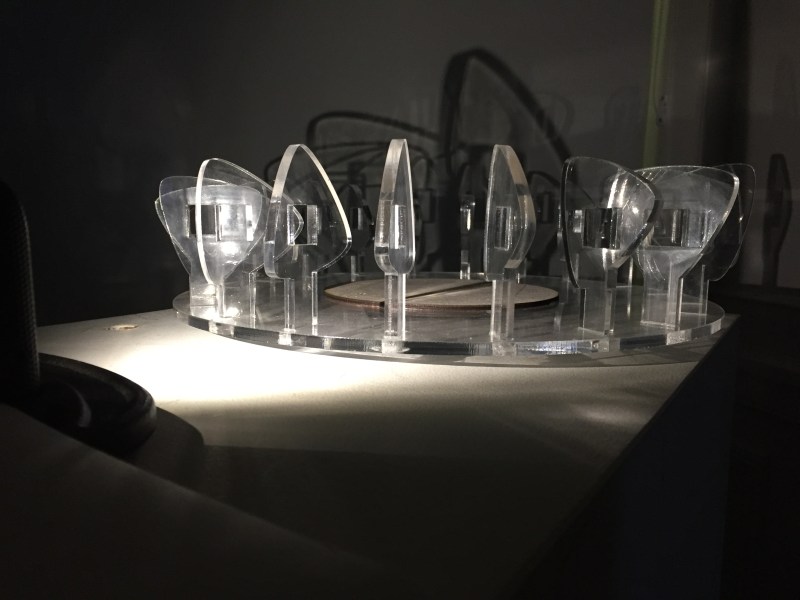Each fall and winter, the Department of Art and Art History hosts Open Studios, an event featuring art created by undergraduate students. This year’s Open Studios took place on Dec. 7 in both the McMurtry building and the Stanford Art Gallery. According to event director Yuri Hobart, Open Studios featured the work of students from more than twenty-five art classes. Throughout the afternoon visitors flooded the venues, evidencing that art, though often crafted in solitude, hardly ever stands far removed from the hubbub of the world: our emotions, our cultures and, more so now than ever before, our technology.
The content of the exhibition highlights the myriad of connections between the abstract and the everyday, challenging the notion of art as distant from the common experience. The ground floor of the Stanford Art Gallery especially explored the space between artisanship and mechanization.
Upon entering the exhibition space, the visitor does not meet a warmly lighted gallery but a dim room illuminated by the electronic glow of computer screens and projectors. Additionally, the sounds are not those of the conventional gallery. Nobody shushes the whirring and beeping of electronics or the voices of visitors as they speak into the microphones of interactive exhibits and inquire the artists about their creations. There is always something to ask and something to explain. All the artwork, originating from the classes “Drawing with Code” and “Embodied Interfaces,” was made with this much in mind.
Senior Abhi Kulgod, for example, designed a device that draws patterns based on music. The device consists of a box with a piece of paper, on which a small robotic arm wields a colored pen and draws upon the command of a remote control. Held together by masking tape, Kulgod’s device demonstrates a philosophical depth beyond its apparent simplicity.
“The idea behind the project is to invert the traditional idea of a record player… it’s taking some music and encoding it into a visual representation,” explained Kulgod, who stressed that he wants “to represent how music influences us, even after we are done listening.” He hopes, through his project, to transform the fleetingness of music into something more visual and permanent.
Through a similar interweaving of artwork and technology, junior Sofya Ogunseitan created a 3D-image hairstyle generator. Ogunseitan explained, “This project is a tool you use to draw braids in 3D, based on curves which you map onto a head, and create complex hairstyles.” Not only does her creation show practical ingenuity, but it also bears cultural significance.
“The hairstyles I used here represent euro-black culture in a way because a lot hairstyles are used to be socially significant in terms of status and culture and spirituality,” noted Ogunseitan.
Other artwork displayed in that sector of the gallery included a computer that told fortunes based on a viewer’s facial structure, an abstract tree sculpture that recorded and played back secrets whispered to it and more projects that interacted with their audiences. The common thread amongst these works, their creation through technology, leads viewers to ponder how society’s increasing automation could influence the changing face of art.
A computer science major, Kulgod believes in the immense additions that technology, particularly artificial intelligence, could bring to art.
“The more that technology advances, the more it will learn to not just imitate what humans do, but generate new types of patterns… that we wouldn’t see usually and new types of patterns that we would find appealing,” he said.
Ogunseitan, however, deviates from Kulgod in her view of the role that technology plays in the creation of artwork.
“It’s important to remember that technology is just a tool for art; it’s not art itself… A lot of times it’s like traditional art is often overlooked because of technology,” she said.
While Kulgod envisions technology as a potential generator of art, she believes it should serve less as a creator and more as supplement, a facilitator.
Gail Wight, the Associate Professor of Art Practice here at Stanford, acknowledges the students’ efforts to grapple with prevalent and challenging technology.
“Our students address this in their work both conceptually and materially – and sometimes they remind us what we are missing, when we pay too much attention to tech companies and their impact,” Wight said.
At the same time, students recognize the potential of technology as a facilitator of the change artists hope to create. “I think it’s important to use those visions and that technology to bring relevant issues to the forefront,” Ogunseitan said.
Art has, indeed, ridden the gales of history’s many “modern times,” using the newest technologies of every era to capture sentiments and relay messages. There should be no fear, then, that the 21st century, with its brilliant machines and ingenious gadgets, should bring about the extinction of art. For artists have never failed to redefine their craft, to metamorphose it while retaining its beauty and profundity, so that it remains both timely and timeless.
Contact Angela Yang at ayang22 ‘at’ stanford.edu.
